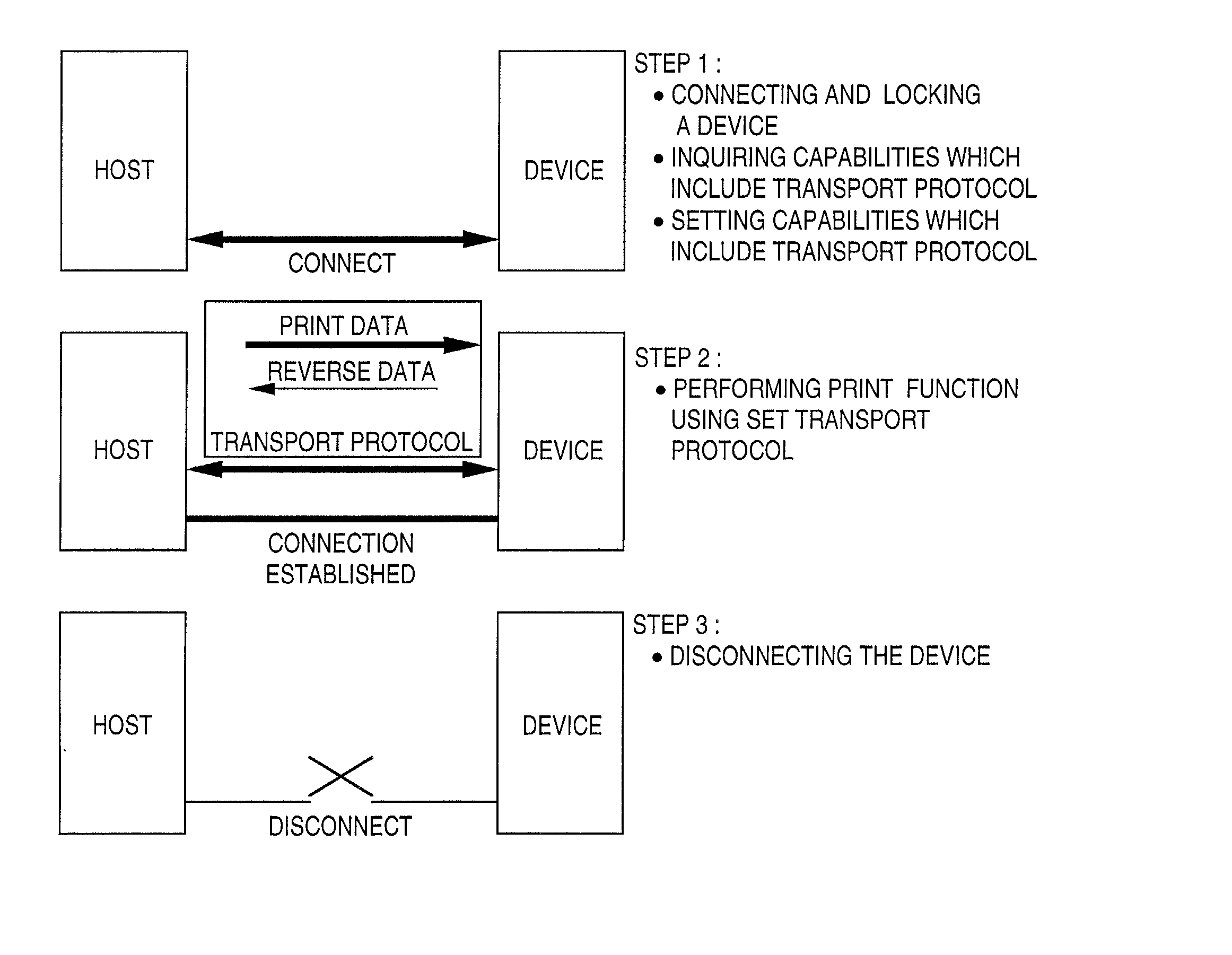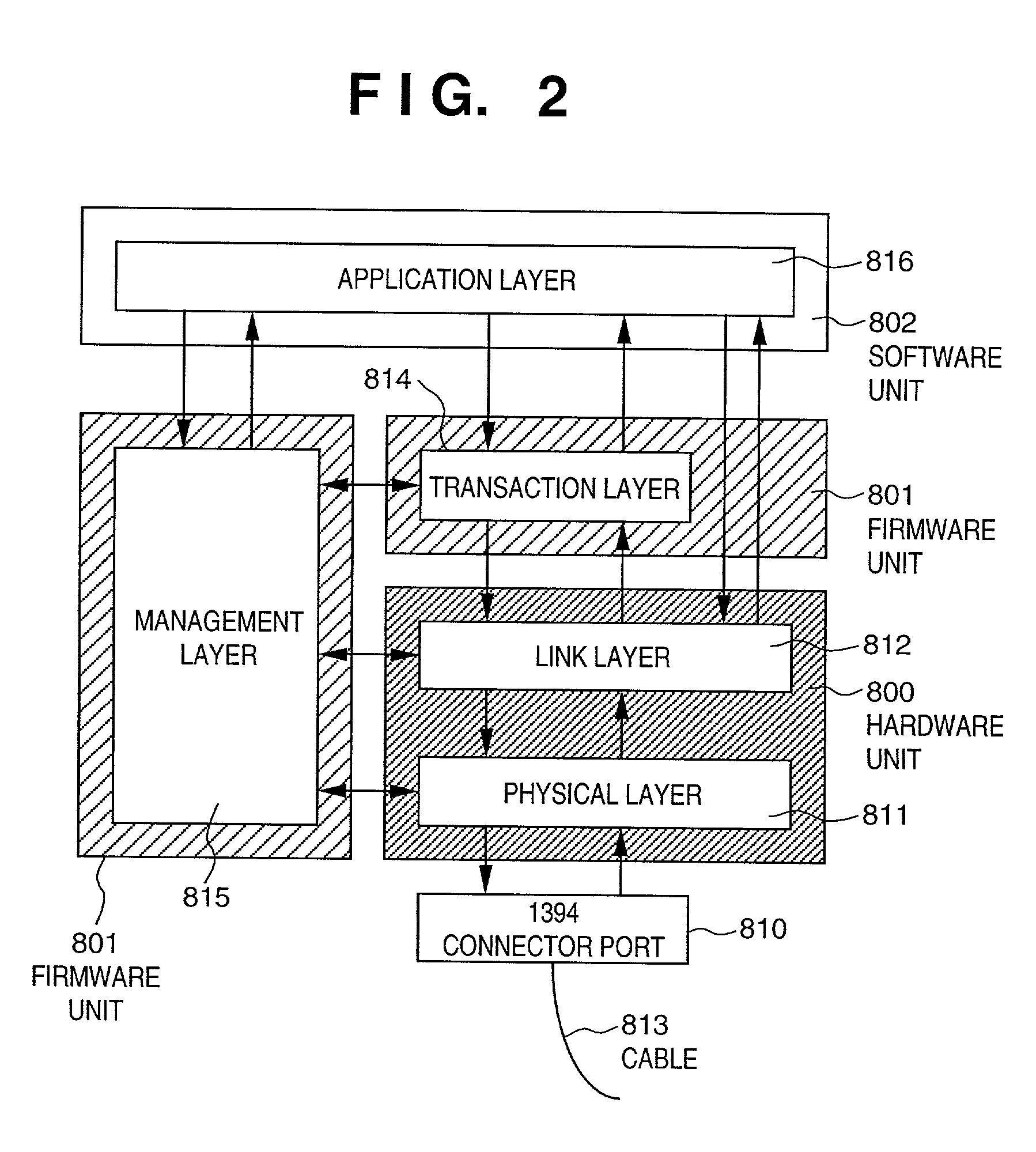Data communication apparatus and method
a technology of data communication and data switching, applied in the field of data communication apparatus and method, can solve problems such as lack of versatility
- Summary
- Abstract
- Description
- Claims
- Application Information
AI Technical Summary
Benefits of technology
Problems solved by technology
Method used
Image
Examples
second embodiment
[0188] Second Embodiment
[0189] FIG. 24 shows the operation according to a second embodiment of the present invention. Compared with the first embodiment as shown in FIG. 18, the second embodiment is applicable to a device having a protocol D in which is not installed in the LOGIN protocol 7. That is, to assure the device only corresponding to the protocol D (e.g., AV / C protocol) of print operation, as well as devices having the LOGIN protocol 7, the printer side has the protocol D.
[0190] In this case, if the printer recognizes, by a print request performed at the beginning of connection, that the host device does not assign a protocol in the LOGIN protocol 7, the printer tries communication with the host device by using the protocol D, and if the communication can be established, the printer executes the print task 10 in accordance with the protocol D.
[0191] FIG. 25 shows the IEEE 1394 serial interface according to the second embodiment in comparison with the OSI model. Example 3 us...
third embodiment
[0193] Third Embodiment
[0194] FIG. 26 is a flowchart showing the LOGIN processing in the printer according to a third embodiment of the present invention. Note that steps identical to those in FIG. 23 have the same step numbers, and detailed explanation of these steps will be omitted.
[0195] Generally, the printer is waiting for log-in by a host device (step S701) . The log-in waiting status (step S701) becomes time-out status after a predetermined period, and at step S712, it is determined whether or not the printer is in time-out status. If the printer is logged in within the predetermined period and it is determined at step S712 that the printer is not in the time-out status, the processing as described in FIG. 23 is performed.
[0196] On the other hand, if the time-out status is determined at step S712, the protocol of the host device is searched (step S713) . Although the details of the protocol search will be described later, the protocol search is for finding a node to be the ho...
fourth embodiment
[0207] Fourth Embodiment
[0208] FIG. 28 is a flowchart showing the protocol majority decision processing performed by a protocol master, i.e., processing to determine a protocol, which is supported by the greatest number of devices, to be used prior to the other protocols, according to a fourth embodiment of the present invention.
[0209] First, initialization processing is performed to count the number of protocols (step S811). Next, it is determined whether or not the information on all the nodes have been obtained (step S812). If the information on all the nodes have not been obtained, the content of the capability register 502 of the node of interest is read out, and settable protocols are counted (step S813). Among protocols available in the respective nodes, the number of protocols commonly used by a plurality of nodes are counted. As a protocol of the greatest number is a protocol used by the greatest number of nodes, this node should be used priori to other nodes, then the proc...
PUM
 Login to View More
Login to View More Abstract
Description
Claims
Application Information
 Login to View More
Login to View More - R&D
- Intellectual Property
- Life Sciences
- Materials
- Tech Scout
- Unparalleled Data Quality
- Higher Quality Content
- 60% Fewer Hallucinations
Browse by: Latest US Patents, China's latest patents, Technical Efficacy Thesaurus, Application Domain, Technology Topic, Popular Technical Reports.
© 2025 PatSnap. All rights reserved.Legal|Privacy policy|Modern Slavery Act Transparency Statement|Sitemap|About US| Contact US: help@patsnap.com



